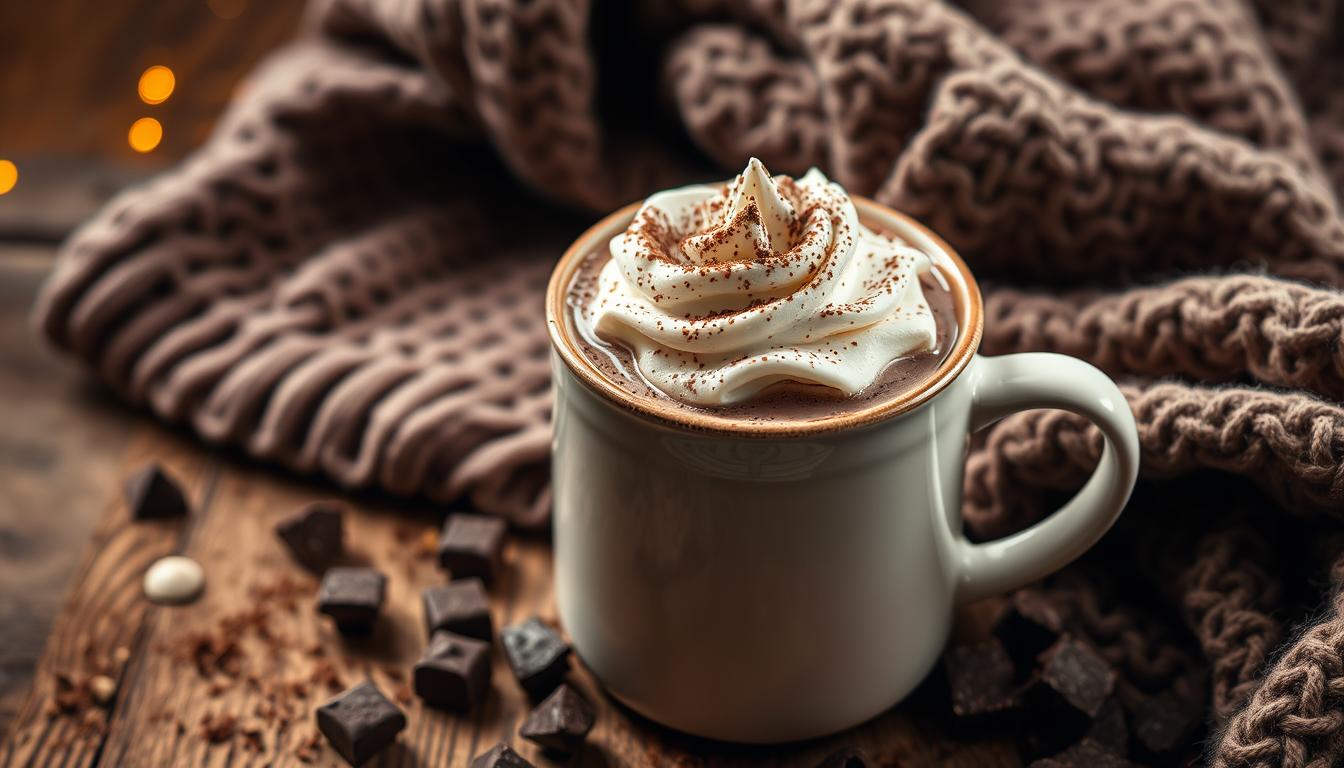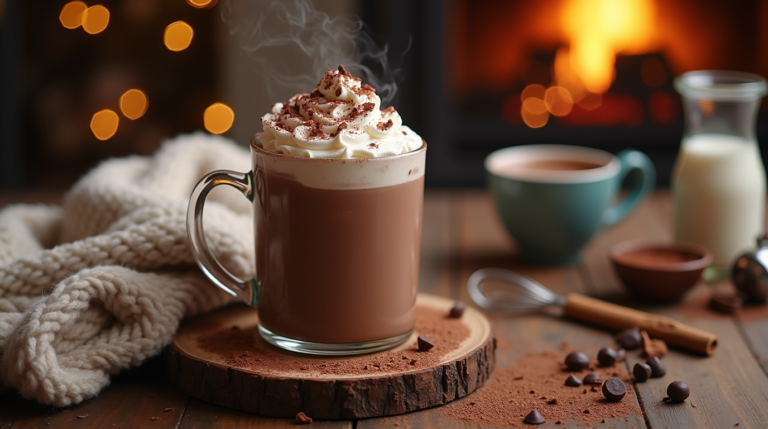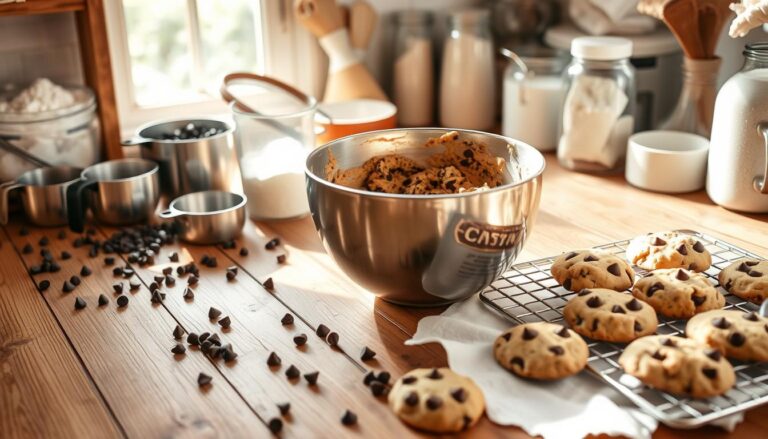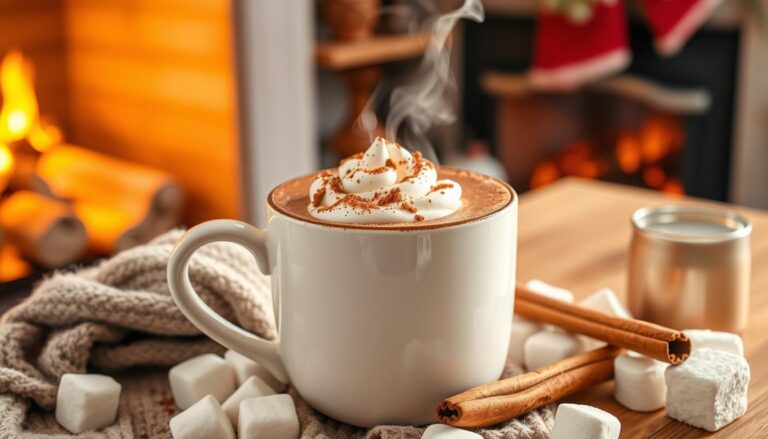Hot Cocoa vs Hot Chocolate
As you explore the world of rich, warming winter beverages, you might wonder about hot cocoa and hot chocolate. Knowing the differences is key to enjoying your winter treats fully. Hot cocoa is a favorite, known for its unique taste.Imagine being cozy with a cup of hot cocoa. It feels warm and comforting.
Table of Contents
The Basics of Hot Cocoa and Hot Chocolate
Hot cocoa and hot chocolate have their own special qualities. The ingredients and how they’re made make each drink unique. Every detail adds to their flavor and experience.
Key Takeaways
- Hot cocoa is a distinct winter beverage with its own unique characteristics.
- Understanding the differences between hot cocoa and hot chocolate can enhance your winter indulgence experience.
- Hot cocoa is a popular choice for its rich, comforting flavor.
- The ingredients and preparation methods used for hot cocoa and hot chocolate set them apart.
- Exploring the world of hot cocoa and hot chocolate can help you discover new favorite winter treats.
- Hot cocoa is a great way to warm up during the cold winter months.
The Basic Differences Between Hot Cocoa and Hot Chocolate
Wondering what makes hot cocoa and hot chocolate different? It’s all about the ingredients and how they’re made. Hot cocoa uses cocoa powder, milk, and sugar. Hot chocolate, on the other hand, is made with melted chocolate, milk, and sugar.
The type of cocoa powder used in hot cocoa can change its taste. Brands like Ghirardelli and Hershey’s make great cocoa powders for homemade hot cocoa. For hot chocolate, high-quality chocolate bars from Lindt or Cadbury are melted with milk and sugar for a creamy drink.
What Defines Hot Cocoa
Hot cocoa is known for its rich, chocolatey taste and creamy feel. It’s a favorite in winter and can be made at home. You can add toppings like whipped cream, marshmallows, or chocolate chips.
What Makes Hot Chocolate Unique
Hot chocolate stands out with its thick, velvety texture and deep chocolate flavor. It’s often made with premium chocolate. You can enjoy it alone or with toppings like fruit or nuts.
Key Distinguishing Features
Hot cocoa and hot chocolate differ in chocolate type, milk ratio, and sweetness. Hot cocoa is often bitter and less sweet. Hot chocolate is richer and more indulgent.

Whether you like hot cocoa or hot chocolate, both are great for warming up on a cold day. Knowing the differences helps you pick the one you prefer and enjoy it fully.
A Rich History of Warming Winter Beverages
As you delve into the world of hot cocoa and hot chocolate, you’ll find a hot cocoa history that’s thousands of years old. These drinks started in ancient Americas, where cacao beans were first grown. They were valued for their taste and health benefits.
Hot cocoa has played a big role in winter celebrations across cultures. In Europe, it’s made with milk and sugar. In Mayan traditions, it’s spicier, with cacao beans and chili peppers. Trying different recipes lets you taste the variety of hot cocoa.
Some key moments in hot cocoa’s history include:
- Ancient Mayans and Aztecs using cacao beans as currency and in sacred rituals
- European colonizers introducing sugar and milk to create a sweeter, creamier hot cocoa
- Modern-day hot cocoa festivals and events celebrating the rich history and cultural significance of these beverages
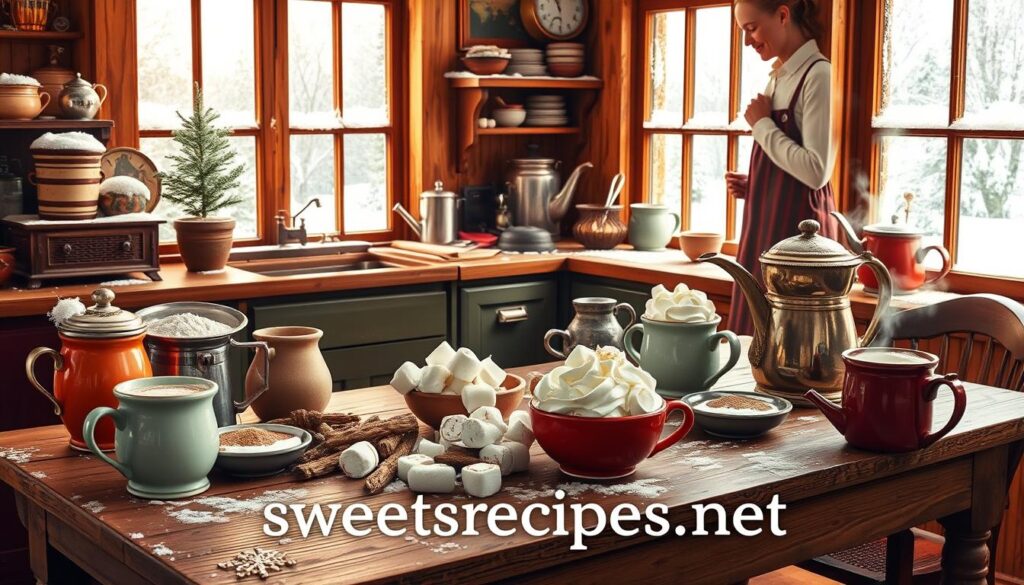
Knowing the hot cocoa history helps you value these drinks more. Whether you like dark hot chocolate or creamy hot cocoa, each sip tells a story. It connects you to a tradition of comfort, community, and joy.
Understanding Hot Cocoa’s Composition and Preparation
To make a tasty cup of hot cocoa, you need to know the key ingredients and how to prepare them. The main ingredients are cocoa powder, sugar, and milk. You can adjust the sugar to your liking. Some people like to use honey or maple syrup instead.
For making hot cocoa, you can use a microwave or a saucepan. The important thing is to heat it slowly and stir often to prevent lumps. You can also add vanilla or cinnamon for a special flavor.
Essential Ingredients
- Cocoa powder
- Sugar
- Milk
- Flavorings (optional)
Step-by-Step Preparation Guide
- Heat the milk in a saucepan or in the microwave
- Add cocoa powder and sugar, stirring constantly
- Bring the mixture to a simmer, whisking continuously
- Remove from heat and add flavorings, if desired
Common Variations and Add-ins
You can make your hot cocoa your own by adding different things. Marshmallows, whipped cream, and chocolate chips are popular choices. You can also try using almond or soy milk for a non-dairy version.
| Ingredient | Description |
|---|---|
| Marshmallows | Adds a sweet and fluffy texture |
| Whipped cream | Adds a rich and creamy texture |
| Chocolate chips | Adds an extra burst of chocolate flavor |
The True Nature of Hot Chocolate
Hot chocolate is a favorite drink with a long history and deep cultural roots. Its taste comes from the chocolate used, with dark, milk, or white chocolate making it special. Enjoying hot chocolate means tasting centuries of traditions and techniques.
Hot chocolate’s cultural value changes around the world. In Mexico, it’s spicy, while European cafes serve creamy versions. Each place adds its own twist, making it a diverse and exciting drink.
- The type and quality of chocolate used
- The ratio of chocolate to milk or other ingredients
- The temperature and preparation method
- The addition of spices, sweeteners, or other flavorings
Knowing these factors lets you try new recipes and find your favorite hot chocolate. Whether you like it simple or spicy, there’s a version for everyone.
Nutritional Comparison and Health Benefits
Hot cocoa and hot chocolate have different nutritional profiles. Hot cocoa is often lower in calories and fat. This makes it a good choice for those watching their weight.
Hot cocoa is rich in antioxidants. These protect the body from damage caused by free radicals. Hot chocolate, while higher in calories and sugar, has flavonoids. These are good for heart health. Choosing hot chocolate with less sugar and adding spices can help enjoy its benefits without the negatives.
Caloric Content Breakdown
A cup of hot cocoa has 100 to 200 calories. Hot chocolate can have 200 to 400 calories. Here’s a comparison:
- 1 cup hot cocoa: 100-200 calories
- 1 cup hot chocolate: 200-400 calories
Beneficial Compounds in Each
Hot cocoa and hot chocolate both have health benefits. Hot cocoa has flavonoids, which improve blood flow and lower blood pressure. Hot chocolate contains theobromine, which boosts mood and reduces stress. Knowing the health benefits of both can help you choose wisely and enjoy them as part of a healthy diet.
Flavor Profiles and Taste Experience
Exploring hot cocoa and hot chocolate reveals a wide range of flavors. Hot cocoa is known for its rich, velvety texture. Hot chocolate, on the other hand, is sweeter and more milky. The ingredients and how they’re prepared can make your winter drinks even better.
The type of cocoa powder used in hot cocoa greatly affects its taste. Dutch-processed cocoa is milder, while natural cocoa is more intense. The milk in hot chocolate also changes its taste. Whole milk makes it creamier, while skim milk is lighter.
To make your hot cocoa and hot chocolate even better, try adding spices, sweeteners, or toppings. Here are some ideas:
- Cinnamon or nutmeg for added warmth and depth
- Whipped cream or marshmallows for a sweet, creamy texture
- Honey or sugar for a touch of sweetness
By trying different ingredients and methods, you can find the perfect flavor for you. Whether you like rich and decadent or light and sweet, there’s something for everyone in hot cocoa and hot chocolate.
| Hot Cocoa Flavor | Hot Chocolate Taste |
|---|---|
| Deep, velvety texture | Sweeter, more milky flavor |
| Influenced by cocoa powder type | Influenced by milk type |
| Can be customized with spices, sweeteners, or toppings | Can be customized with spices, sweeteners, or toppings |
Best Serving Practices and Temperature Tips
Serving hot cocoa and hot chocolate at the right temperature is key. It brings out the flavors, making it a great winter treat. The best temperature for hot chocolate is between 160°F and 180°F. This balances the richness of the chocolate.
To make your hot chocolate better, try these tips:
- Use high-quality chocolate for the best flavor
- Experiment with different types of milk, such as almond or soy milk, for a non-dairy option
- Add a pinch of salt to balance the sweetness
For hot cocoa, add toppings like whipped cream, marshmallows, or chocolate shavings. The goal is to mix flavors and textures well. Always store hot cocoa and hot chocolate in airtight containers. This keeps the flavor and aroma fresh.
Ideal Temperature Guidelines
The right temperature is important for hot cocoa and hot chocolate. For hot chocolate, aim for 160°F to 180°F. Hot cocoa can be a bit cooler.
Serving Suggestions
Here are some ways to serve hot cocoa and hot chocolate:
- Serving in large mugs with whipped cream and marshmallows
- Pairing with sweet treats, such as cookies or brownies
- Using as a base for other desserts, such as hot chocolate cake
| Drink | Ideal Temperature | Serving Suggestions |
|---|---|---|
| Hot Cocoa | 155°F – 165°F | Whipped cream, marshmallows, chocolate shavings |
| Hot Chocolate | 160°F – 180°F | Whipped cream, chocolate syrup, chopped nuts |
Conclusion: Choosing Between Hot Cocoa and Hot Chocolate
The difference between hot cocoa and hot chocolate is clear. It’s about what goes into them and how they taste. Both are great for warming up when it’s cold outside.
Think about what you like and what you need when choosing. Hot cocoa is lighter and less rich. Hot chocolate is creamy and indulgent. Try different recipes and toppings to find your favorite.
Enjoy your drink, whether it’s hot cocoa or hot chocolate. Let the smell and taste take you to a cozy winter place. Don’t be shy to try new things and find your ultimate comfort drink.
FAQ
What is the difference between hot cocoa and hot chocolate?
Hot cocoa and hot chocolate differ in ingredients and how they’re made. Hot cocoa uses cocoa powder, milk, and sweeteners. Hot chocolate, on the other hand, melts chocolate into milk, sometimes adding spices or cream.
What defines hot cocoa?
Hot cocoa is a warm drink made from cocoa powder, sugar, and milk or water. It has a lighter taste than hot chocolate.
What makes hot chocolate unique?
Hot chocolate is richer and creamier. It’s made by melting chocolate into milk or cream. This gives it a deeper chocolate flavor and a thicker texture than hot cocoa.
What are the key distinguishing features between hot cocoa and hot chocolate?
The main differences are in ingredients and taste. Hot cocoa uses cocoa powder, while hot chocolate melts chocolate. Hot cocoa is lighter, and hot chocolate is richer.
What is the history of hot cocoa and hot chocolate?
Both have ancient roots. Hot chocolate came to Europe in the 16th century. Hot cocoa emerged in the 19th century with cocoa powder, making it more accessible.
What are the essential ingredients in hot cocoa?
Hot cocoa needs cocoa powder, sugar, and milk or water. You might also add vanilla, cinnamon, or other spices.
How do you prepare a cup of hot cocoa?
Start by mixing cocoa powder, sugar, and a bit of hot water or milk. Then, add more milk or water and heat until it’s steaming. Top with whipped cream or marshmallows if you like.
What are some common variations and add-ins for hot cocoa?
You can add cinnamon, nutmeg, vanilla, peppermint, or even a bit of coffee or liquor. Try different milks like almond or oat for unique tastes.
What defines the true nature of hot chocolate?
True hot chocolate is rich and decadent. It’s made by melting high-quality chocolate into milk or cream. The chocolate type and added spices or ingredients affect its flavor.
What are the nutritional differences between hot cocoa and hot chocolate?
Hot cocoa usually has fewer calories and less fat than hot chocolate. But, the nutritional content varies based on ingredients and preparation. Always check the calories and health benefits of each.
How do the flavor profiles of hot cocoa and hot chocolate differ?
Hot cocoa tastes lighter and more delicate. Hot chocolate is richer and creamier. The flavor can change based on the cocoa or chocolate type and added ingredients.
What are the ideal serving temperatures for hot cocoa and hot chocolate?
Both should be served between 160-180°F (71-82°C). This ensures they’re hot but not too hot. Proper storage and reheating are key to keeping the perfect temperature and flavor.

